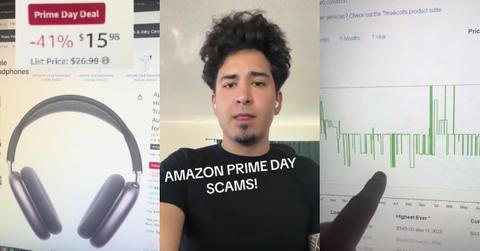“Tired of Being Scammed” — Amazon Customer Says Prime Day Is a Con Job, Shares Hack for Real Discounts
"SOME things are on sale though."
Published July 17 2024, 11:17 a.m. ET

You might be getting taken behind the woodshed on Prime Day, one TikToker claims.
Jaymes (@semyajnotsemaj) posted a viral TikTok urging customers who, excited to lap up the deals promised by Amazon, should think twice before making a purchase.
He recommends utilizing a price monitoring website, as he says that Amazon engages in a familiar practice that a lot of other stores like to do ahead of Black Friday — artificially pump up the cost of products and then effectively lie about how steep of a discount shoppers are actually getting.
Several other users on the application said that they've noticed the same exact thing, and if you want to make sure you're getting Amazon's absolute best price on a product before committing to shelling out your hard earned cash, you may want to listen to Jaymes's video.
"Amazon Prime Day Scams!" a text overlay in the video reads. Jaymes then explains: "OK, do not buy anything on Amazon before watching this," he states, before his video cuts to footage of him browsing Amazon's website.
He begins talking about the annual sales event extravaganza known as Amazon Prime Day, which promises a bunch of bottom-dollar, door-busting deals on products that more than likely get online shoppers whipped up into a frenzy and thinking they need to act fast.
However, Jaymes says that this isn't necessarily the case and folks should think twice before clicking that "add to cart" button:
"It's Prime Day on Amazon, so you think everything's on sale, right? Wrong. Here I have an example: INIU Wireless Charger, $15.98 that's 41 percent off! That's crazy right?"

The only thing that's crazy, Jaymes goes on to show, is that customers are potentially being misled as to how steep of a discount they're getting on the product. "But if you take the link and copy it and you go over to this website right here: it's called camelcamelcamel.com, put the link in up there and search it, you find it, then you'll notice right before Prime Day, they jumped it up to $24.98, it was usually right over here around $16," he says, showing a graph of the Amazon price history of the item, which is tracked by the site.
Judging from this product link page on the price-tracking website Jaymes displays in his TikTok, the chart indicates that whoever was in charge of pricing at Amazon decided to jack up the price right before Prime Day.

So, technically, the product did receive a 41 percent discount ... but only from the jacked-up price. Typically it retailed for the same price it's always been sold for.
"Dude, they had never sold it for that high but they did for Prime Day and they gave you a 41 percent discount on a fake price," he states.
His clip then transitions to him showing off a pair of wireless over-the-ear headphones — "And the beauty of this website is you can find something like the Apple AirPods Max and confirm that 400 bucks is in fact the best price they've offered in a long time," he states, showing the Amazon chart which details that the $394 retail price is indeed, the lowest cost they've ever sold the item for.
He points to the chart: "Lowest you've ever seen is around $430, but over here, four hundred bucks. That's how you find a good deal on Amazon," he states before the video ultimately closes out.

One TikToker who responded to his video remarked that it's not just Amazon that pulls this kind of pricing stunt before Prime Day, and that tons of other retailers engage in this same practice: "Not just Amazon, every store does this now," they penned.
Another user on the application stated that folks don't even need to go to a separate website to track the URLs, they can add an extension to their browser that allows customers to simply highlight a product price and then track its cost history right on the web page: "Keepa is even better. You can add a plugin to your browser that embeds the price history graph right into the Amazon page."
Other users on the application said that they, too, noticed the pre-Prime Day price hikes. Some said that the prices of the items didn't even change and that Amazon simply changed the font of the prices on their respective item web pages: "I took snapshots at the beginning of the month on things I wanted to buy. Today, most of them were the same price but in a different font. I'm so tired of being scammed," one wrote.